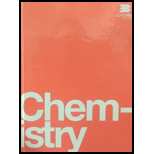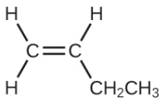
Chemistry by OpenStax (2015-05-04)
1st Edition
ISBN: 9781938168390
Author: Klaus Theopold, Richard H Langley, Paul Flowers, William R. Robinson, Mark Blaser
Publisher: OpenStax
expand_more
expand_more
format_list_bulleted
Concept explainers
Textbook Question
Chapter 3, Problem 5E
Determine the molecular mass of the following compounds:



Expert Solution & Answer
Want to see the full answer?
Check out a sample textbook solution
Students have asked these similar questions
Reason whether it is possible to determine changes in the Galvani potential difference at the metal-solution interface.
Obtain the standard potential at 25°C of the Cu* I Cu | Pt electrode
from the standard potentials E°
Cu²+/Cu
= 0.341 V and E
Cu²+ /Cu+
= 0.153 V.
In electrochemistry, briefly describe the Galvani potential, the Volta potential, and the surface potential. Differentiate between them.
Chapter 3 Solutions
Chemistry by OpenStax (2015-05-04)
Ch. 3 - What is the total mass (amu) of carbon in each of...Ch. 3 - What is the total mass of hydrogen in each of the...Ch. 3 - Calculate the molecular or formula mass of each of...Ch. 3 - Determine the molecular mass of the following...Ch. 3 - Determine the molecular mass of the following...Ch. 3 - Which molecule has a molecular mass of 28.05 amu?Ch. 3 - Write a sentence that describes how to determine...Ch. 3 - Compare 1 mole of H2, 1 mole of O2, and 1 mole of...Ch. 3 - Which contains the greatest mass of oxygen: 0.75...Ch. 3 - Which contains the greatest number of moles of...
Ch. 3 - How are the molecular mass and the molar mass of a...Ch. 3 - Calculate the molar mass of each of the following...Ch. 3 - Calculate the molar mass of each of the following:...Ch. 3 - Calculate the empirical or molecular formula mass...Ch. 3 - Calculate the molar mass of each of the following:...Ch. 3 - Determine the number of moles of compound and the...Ch. 3 - Determine the mass of each of the following: 0.0...Ch. 3 - Determine the number of moles of the compound and...Ch. 3 - Determine the mass of each of the following: 2.345...Ch. 3 - The approximate minimum daily dietary requirement...Ch. 3 - Determine the mass in grams of each of the...Ch. 3 - A 55-kg woman has 7.5103 mol of hemoglobin (molar...Ch. 3 - Determine the number of atoms and the mass of...Ch. 3 - Determine which of the following contains the...Ch. 3 - Determine which of the following contains the...Ch. 3 - Diamond is one form of elemental carbon. An...Ch. 3 - The Cullinan diamond was the largest natural...Ch. 3 - One 55-gram serving of a particular cereal...Ch. 3 - A certain nut crunch cereal contains 11.0 grams of...Ch. 3 - A tube of toothpaste contains 0.76 g of sodium...Ch. 3 - Which of the following represents the least number...Ch. 3 - What information do we need to determine the...Ch. 3 - Calculate the following to four significant...Ch. 3 - Determine the following to four significant...Ch. 3 - Determine the percent ammonia, NH3, in Co(...Ch. 3 - Determine the percent water in CuSO45H2O to three...Ch. 3 - Determine the empirical formulas for compounds...Ch. 3 - Determine the empirical formulas for compounds...Ch. 3 - A compound of carbon and hydrogen contains 92.3% C...Ch. 3 - Dichioroethane, a compound that is often used for...Ch. 3 - Determine the empirical and molecular formula for...Ch. 3 - Polymers are large molecules composed of simple...Ch. 3 - A major textile dye manufacturer developed a new...Ch. 3 - Explain what changes and what stays the same when...Ch. 3 - What information do we need to calculate the...Ch. 3 - What does it mean when we say that a 200-mL sample...Ch. 3 - Determine the molarity for each of the following...Ch. 3 - Determine the molarity of each of the following...Ch. 3 - Consider this question: What is the mass of the...Ch. 3 - Consider this question: What is the mass of solute...Ch. 3 - Calculate the number of moles and the mass of the...Ch. 3 - Calculate the number of moles and the mass of the...Ch. 3 - Consider this question: What is the molarity of...Ch. 3 - Consider this question: What is the molarity of...Ch. 3 - Calculate the molarity of each of the following...Ch. 3 - Calculate the molarity of each of the following...Ch. 3 - There is about 1.0 g of calcium, as Ca2+, in LO L...Ch. 3 - What volume of a 1.00MFe( NO3)3 solution can be...Ch. 3 - If 0.1718 L of a 0.3556-M C3H7OH solution is...Ch. 3 - If 4.12 L of a 0.850 MH3PO4 solution is be diluted...Ch. 3 - What volume of a 0.33MC12H22O11 solution can be...Ch. 3 - What is the concentration of the NaCl solution...Ch. 3 - What is the molarity of the diluted solution when...Ch. 3 - What is the final concentration of the solution...Ch. 3 - A 2.00-L bottle of a solution of concentrated HCl...Ch. 3 - An experiment in a general chemistry laboratory...Ch. 3 - What volume of a 0.20MK2SO4 solution contains 57 g...Ch. 3 - The US Environmental Protection Agency (EPA)...Ch. 3 - Consider this question: What mass of a...Ch. 3 - What mass of a 4.00% NaOH solution by mass...Ch. 3 - What mass of solid NaOH (97.0% NaOH by mass) is...Ch. 3 - What mass of HCl is contained in 45.0 mL of an...Ch. 3 - The hardness of water (hardness count) is usually...Ch. 3 - The hardness of water (hardness count) is usually...Ch. 3 - In Canada and the United Kingdom, devices that...Ch. 3 - A throat spray is 1.40% by mass phenol, C6H5OH, in...Ch. 3 - Copper(I) iodide (CuI) is often added to table...Ch. 3 - A cough syrup contains 5.0% ethyl alcohol, C2H5OH,...Ch. 3 - D5W is a solution used as an intravenous fluid. It...Ch. 3 - Find the molarity of a 40.0% by mass aqueous...
Additional Science Textbook Solutions
Find more solutions based on key concepts
What color of light is least effective in driving photosynthesis? Explain.
Campbell Biology (11th Edition)
Fibrous connective tissue consists of ground substance and fibers that provide strength, support, and flexibili...
Human Biology: Concepts and Current Issues (8th Edition)
16. Explain some of the reasons why the human species has been able to expand in number and distribution to a g...
Campbell Biology: Concepts & Connections (9th Edition)
Dr. Ara B. Dopsis and Dr. C. Ellie Gans are performing genetic crosses on daisy plants. They self-fertilize a b...
Genetic Analysis: An Integrated Approach (3rd Edition)
Where are skeletal cartilages located?
Human Anatomy & Physiology (2nd Edition)
A source of electromagnetic radiation produces infrared light. Which of the following could be the wavelength ...
Chemistry: The Central Science (14th Edition)
Knowledge Booster
Learn more about
Need a deep-dive on the concept behind this application? Look no further. Learn more about this topic, chemistry and related others by exploring similar questions and additional content below.Similar questions
- What substances can neutralize, complex or adsorb and absorb both HF and CF carbonyl fluoride and hydrogen fluoride and intermediate formation of thermal decomposition of fluorinated inorganic compounds either due to hydrolysis and hygroscopic reactions. What is the known chemistry of these reactions and mechanisms.arrow_forwardBriefly differentiate between chemical potential and electrochemical potential.arrow_forwardAccording to open access forums ionic antimony Sb (111) can be reduced to elemental Sb (0) in solution and in macromolecules like condensation polymers polyethylene terephthalate (PET) causing greying of the polymer matrix. It has been connected to thermal degradation of the polymer during processing to the formation of thermally unstable EG ethyleen glycol that forms at various temperatures formic acid, formaldehyde, acetaldehyde and much more depending on temperature. I need to know what organics are more powerful reducing agents and at what concentration (relative) to each organic will initiate this reduction. Furthermore, is the pH dependant ? Are other trace elements in the plastic also a cause of concern e.g. aluminum from aluminum chloride (lewis acid). Therefore, the ultimate solution should include a means to inhibit reduction of ionic antimony and will the same solution comply with cobalt impurities from ionic cobalt? Some PET have combinations of catalyst and their residues…arrow_forward
- From a pH standpoint is the reduction of ionic Antimony Sb (111) to elemental Sb (0) occur more readily by acidic species acting as reducing agents or basic substances? I want to inhibit this reduction of ionic to elemental. Suggestions and directions!arrow_forwardObtain the standard potential at 25°C of the Cu* I Cu | Pt electrode from the standard potentials E° Cu²+/Cu = 0.341 V and E Cu²+ /Cu+ = 0.153 V.arrow_forwardState two variables on which the transport number in electrochemistry depends.arrow_forward
arrow_back_ios
SEE MORE QUESTIONS
arrow_forward_ios
Recommended textbooks for you
 Chemistry by OpenStax (2015-05-04)ChemistryISBN:9781938168390Author:Klaus Theopold, Richard H Langley, Paul Flowers, William R. Robinson, Mark BlaserPublisher:OpenStax
Chemistry by OpenStax (2015-05-04)ChemistryISBN:9781938168390Author:Klaus Theopold, Richard H Langley, Paul Flowers, William R. Robinson, Mark BlaserPublisher:OpenStax
 Chemistry: An Atoms First ApproachChemistryISBN:9781305079243Author:Steven S. Zumdahl, Susan A. ZumdahlPublisher:Cengage Learning
Chemistry: An Atoms First ApproachChemistryISBN:9781305079243Author:Steven S. Zumdahl, Susan A. ZumdahlPublisher:Cengage Learning ChemistryChemistryISBN:9781305957404Author:Steven S. Zumdahl, Susan A. Zumdahl, Donald J. DeCostePublisher:Cengage Learning
ChemistryChemistryISBN:9781305957404Author:Steven S. Zumdahl, Susan A. Zumdahl, Donald J. DeCostePublisher:Cengage Learning Chemistry & Chemical ReactivityChemistryISBN:9781133949640Author:John C. Kotz, Paul M. Treichel, John Townsend, David TreichelPublisher:Cengage Learning
Chemistry & Chemical ReactivityChemistryISBN:9781133949640Author:John C. Kotz, Paul M. Treichel, John Townsend, David TreichelPublisher:Cengage Learning

Chemistry by OpenStax (2015-05-04)
Chemistry
ISBN:9781938168390
Author:Klaus Theopold, Richard H Langley, Paul Flowers, William R. Robinson, Mark Blaser
Publisher:OpenStax


Chemistry: An Atoms First Approach
Chemistry
ISBN:9781305079243
Author:Steven S. Zumdahl, Susan A. Zumdahl
Publisher:Cengage Learning

Chemistry
Chemistry
ISBN:9781305957404
Author:Steven S. Zumdahl, Susan A. Zumdahl, Donald J. DeCoste
Publisher:Cengage Learning


Chemistry & Chemical Reactivity
Chemistry
ISBN:9781133949640
Author:John C. Kotz, Paul M. Treichel, John Townsend, David Treichel
Publisher:Cengage Learning
Mass Spectrometry; Author: Professor Dave Explains;https://www.youtube.com/watch?v=hSirWciIvSg;License: Standard YouTube License, CC-BY
